Optimizing Waste Heat Conversion: Integrating Phase-Change Material Heatsinks and Wind Speed Dynamics to Enhance Flexible Thermoelectric Generator Efficiency
Abstract
:1. Introduction
2. Experimental Section
2.1. Flexible Thermoelectric Design and Fabrication
2.2. Flexible Heatsink Fabrication
2.3. Output Power Measurement Setup
3. Results and Discussion
3.1. Flexible Thermoelectric Module
3.2. Experimental Results of FTEG Integrated with Flexible Heatsink
3.3. Application Demonstrations
4. Conclusions
Author Contributions
Funding
Institutional Review Board Statement
Informed Consent Statement
Data Availability Statement
Conflicts of Interest
References
- Forman, C.; Muritala, I.K.; Pardemann, R.; Meyer, B. Estimating the global waste heat potential. Renew. Sustain. Energy Rev. 2016, 57, 1568–1579. [Google Scholar] [CrossRef]
- Li, T.; Zhang, X.; Lacey, S.D.; Mi, R.; Zhao, X.; Jiang, F.; Song, J.; Liu, Z.; Chen, G.; Dai, J. Cellulose ionic conductors with high differential thermal voltage for low-grade heat harvesting. Nat. Mater. 2019, 18, 608–613. [Google Scholar] [CrossRef] [PubMed]
- Lee, S.W.; Yang, Y.; Lee, H.-W.; Ghasemi, H.; Kraemer, D.; Chen, G.; Cui, Y. An electro-chemical system for efficiently harvesting low-grade heat energy. Nat. Commun. 2014, 5, 3942. [Google Scholar] [CrossRef] [PubMed]
- Poletayev, A.D.; McKay, I.S.; Chueh, W.C.; Majumdar, A. Continuous electrochemical heat engines. Energy Environ. Sci. 2018, 11, 2964–2971. [Google Scholar] [CrossRef]
- Cao, T.; Shi, X.L.; Chen, Z.G. Advances in the design and assembly of flexible thermoelectric device. Prog. Mater. Sci. 2023, 131, 101003. [Google Scholar] [CrossRef]
- Toan, N.V.; Tuoi, T.T.K.; Sui, H.; Trung, N.H.; Samat, K.F.; Ono, T. Ultra-flexible thermoelectric generator sheet and electrodeposited thermoelectric material for waste heat harvesting. Energy Rep. 2022, 8, 5026–5037. [Google Scholar] [CrossRef]
- Gobpant, J.; Klongratog, B.; Rudradawong, C.; Sakdanuphab, R.; Junlabhut, P.; Nuthongkum, P.; Limsuwan, P.; Sakulkalavek, A. High-performance flexible thermoelectric generator based on silicone rubber and cover with graphite sheet. Appl. Therm. Eng. 2024, 236, 121656. [Google Scholar] [CrossRef]
- Shi, Y.; Wang, Y.; Mei, D.; Feng, B.; Chen, Z. Design and fabrication of wearable thermoelectric generator device for heat harvesting. IEEE Robot. Autom. Lett. 2018, 3, 373–378. [Google Scholar] [CrossRef]
- Zhou, Z.; Huang, Y.; Wei, B.; Yang, Y.; Yu, D.; Zheng, Y.; He, D.; Zhang, W.; Zou, M.; Lan, J.-L.; et al. Compositing effects for high thermoelectric performance of Cu2Se-based materials. Nat. Commun. 2023, 14, 2410. [Google Scholar] [CrossRef]
- Xie, L.; Yin, L.; Yu, Y.; Peng, G.; Song, S.; Ying, P.; Cai, S.; Sun, Y.; Shi, W.; Wu, H.; et al. Screening strategy for developing thermoelectric interface materials. Science 2023, 382, 921–928. [Google Scholar] [CrossRef]
- Lee, B.; Cho, H.; Park, K.T.; Kim, J.S.; Park, M.; Kim, H.; Hong, Y.; Chung, S. High-performance compliant thermoelectric generators with magnetically self-assembled soft heat conductors for self-powered wearable electronics. Nat. Commun. 2020, 11, 5948. [Google Scholar] [CrossRef] [PubMed]
- Maksymuk, M.; Parashchuk, T.; Dzundza, B.; Nykyruy, L.; Chernyak, L.; Dashevsky, Z. Highly efficient bismuth telluride-based thermoelectric micro converter. Mater. Today Energy 2021, 21, 100753. [Google Scholar] [CrossRef]
- Mao, X.; Li, Z.; Liu, Y.; Nie, X.; Li, B.; Jiang, Q.; Gao, C.; Gao, Y.; Wang, L. Tuning the structure of borane-nitrogen derivatives towards high-performance carbon nanotubes-based n-type thermoelectric materials. Chem. Eng. J. 2021, 405, 126616. [Google Scholar] [CrossRef]
- Xu, Q.; Deng, B.; Zhang, L.; Lin, S.; Han, Z.; Zhou, Q.; Li, J.; Zhu, Y.; Jiang, F.; Li, Q.; et al. High-performance flexible thermoelectric generator based on bulk materials. Cell Rep. Phys. Sci. 2022, 3, 100780. [Google Scholar] [CrossRef]
- Kim, S.J.; We, J.H.; Cho, B.J. A wearable thermoelectric generator fabricated on a glass fabric. Energy Environ. Sci. 2014, 7, 1959–1965. [Google Scholar] [CrossRef]
- Jeong, M.H.; Kim, K.-C.; Kim, J.-S.; Choi, K.J. Operation of wearable thermoelectric generators using dual sources of heat and light. Adv Sci. 2022, 9, 2104915. [Google Scholar] [CrossRef] [PubMed]
- Lv, J.-R.; Ma, J.-L.; Dai, L.; Yin, T.; He, Z.-Z. A high-performance wearable thermoelectric generator with comprehensive optimization of thermal resistance and voltage boosting conversion. Appl. Energy 2022, 312, 118696. [Google Scholar] [CrossRef]
- Kuang, N.; Niu, A.; Wang, W.; Zuo, Z.; Zhan, T.; Wang, H. High performance flexible thermoelectric generator using bulk legs and integrated electrodes for human energy harvesting. Energy Convers. Manag. 2022, 272, 116337. [Google Scholar] [CrossRef]
- Kim, C.S.; Yang, H.M.; Lee, J.; Lee, G.S.; Choi, H.; Kim, Y.J.; Lim, S.H.; Cho, S.H.C.B.J. Self- powered wearable electrocardiography using a wearable thermoelectric power generator. ACS Energy Lett. 2018, 3, 501–507. [Google Scholar] [CrossRef]
- Park, H.; Kim, D.; Eom, Y.; Wijethunge, D.; Hwang, J.; Kim, H.; Kim, W. Mat-like flexible thermoelectric system based on rigid inorganic bulk materials. J. Phys. D Appl. Phys. 2017, 50, 494006. [Google Scholar] [CrossRef]
- Park, H.; Lee, D.; Kim, D.; Cho, H.; Eom, Y.; Hwang, J.; Kim, H.; Kim, J.; Han, S.; Kim, W. High power output from body heat harvesting based on flexible thermoelectric system with low thermal contact resistance. J. Phys. D Appl. Phys. 2018, 51, 365501. [Google Scholar] [CrossRef]
- Lee, G.; Kim, C.S.; Kim, S.; Kim, Y.J.; Choi, H.; Cho, B.J. Flexible heatsink based on a phase-change material for a wearable thermoelectric generator. Energy 2019, 179, 12–18. [Google Scholar] [CrossRef]
- Prasad, J.S.; Anandalakshmi, R.; Muthukumar, P. Numerical investigation on conventional and PCM heat sinks under constant and variable heat flux conditions. Clean. Techn. Environ. Policy 2021, 23, 1105–1120. [Google Scholar] [CrossRef]
- Desai, A.N.; Shah, H.; Singh, V.K. Novel inverted fin configurations for enhancing the thermal performance of PCM based thermal control unit: A numerical study. Appl. Therm. Eng. 2021, 195, 117155. [Google Scholar] [CrossRef]
- Zhu, S.; Miao, L.; Peng, Y.; Gao, J.; Lai, H.; Liu, C.; Zhang, Y.; Zhang, X.; Chen, Z.; Pei, Y. Persistently self-powered wearable thermoelectric generator enabled by phase-change inorganics as the heat sink. Mater. Today Phys. 2023, 32, 101011. [Google Scholar] [CrossRef]
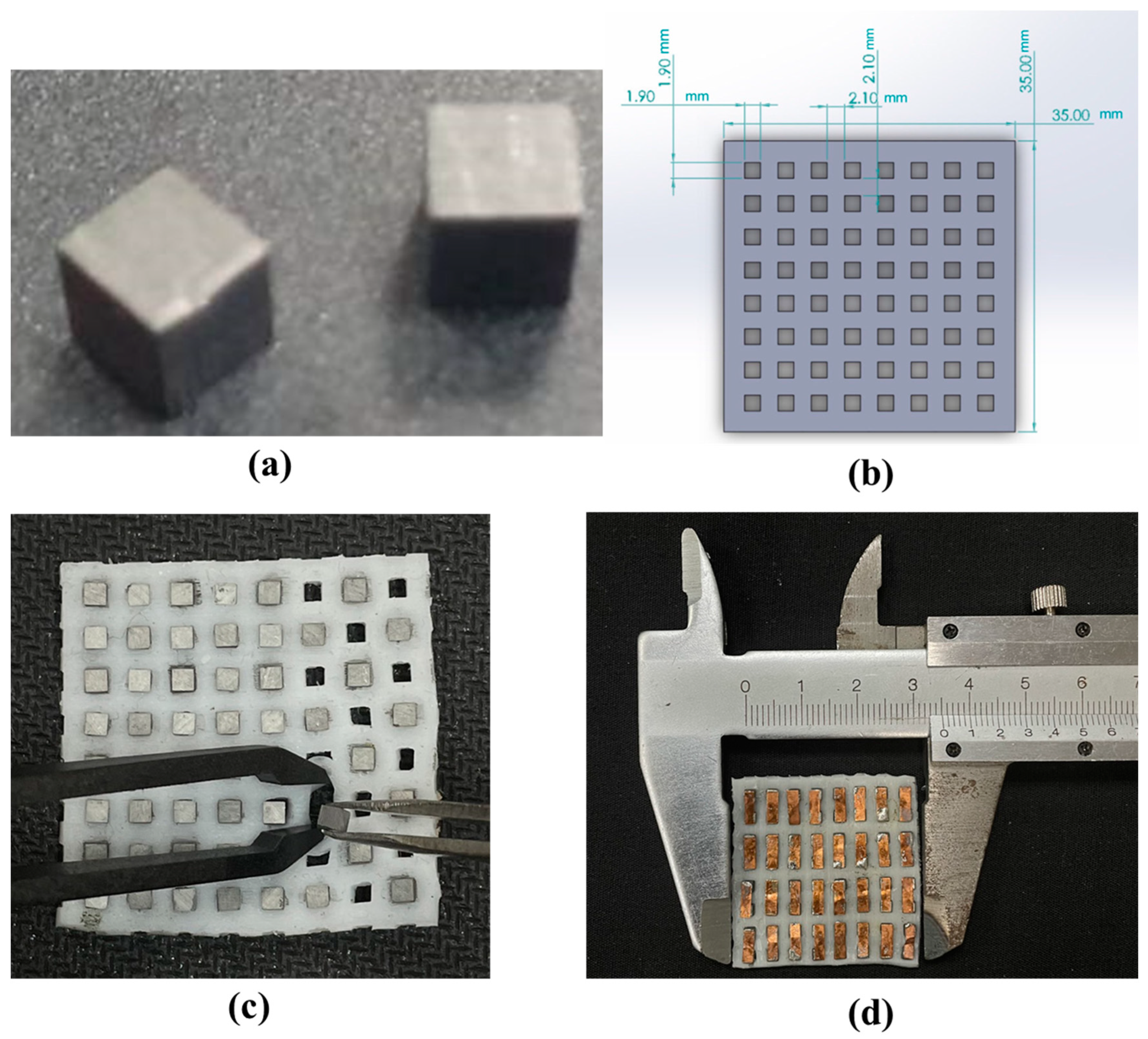


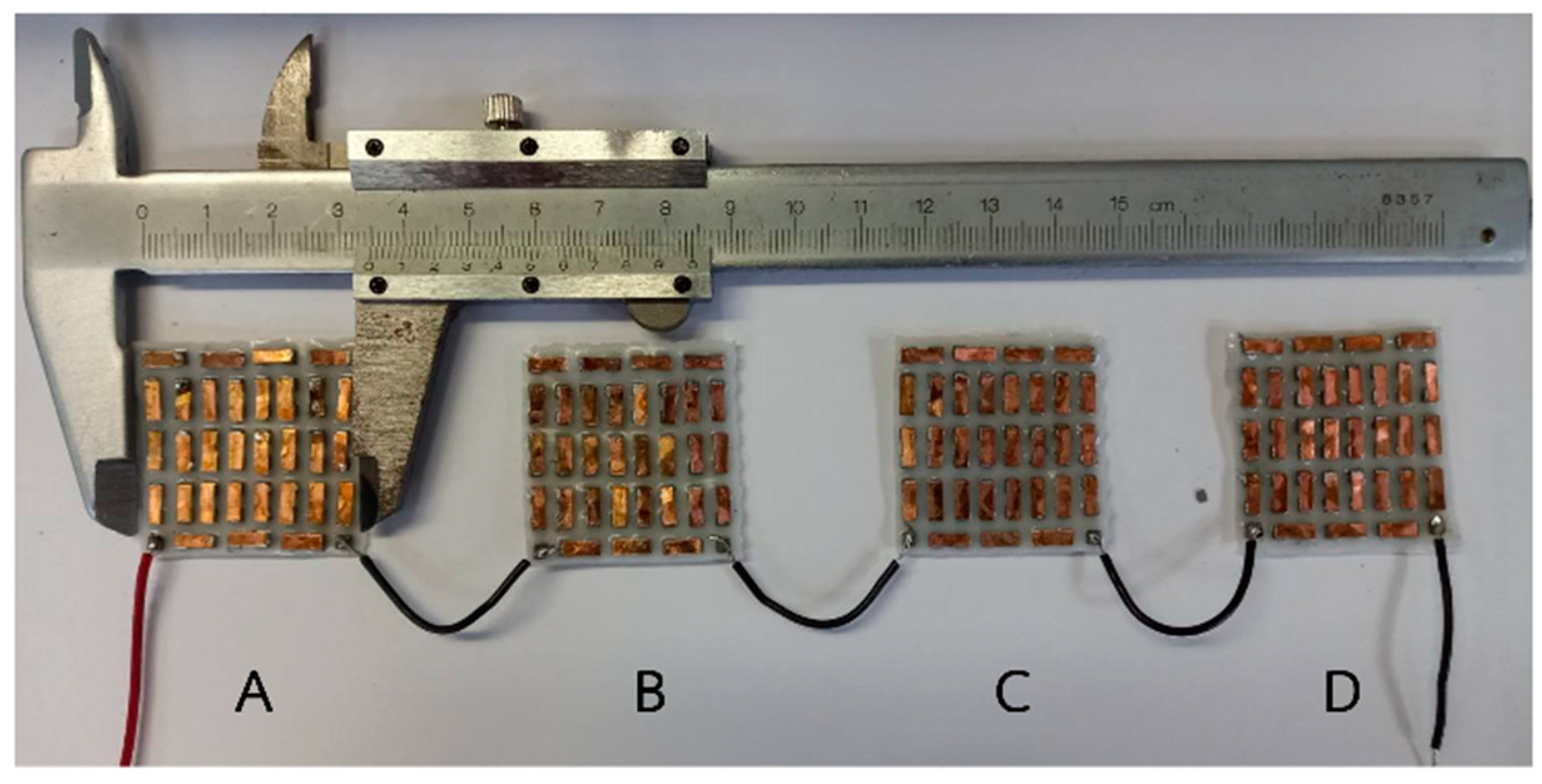



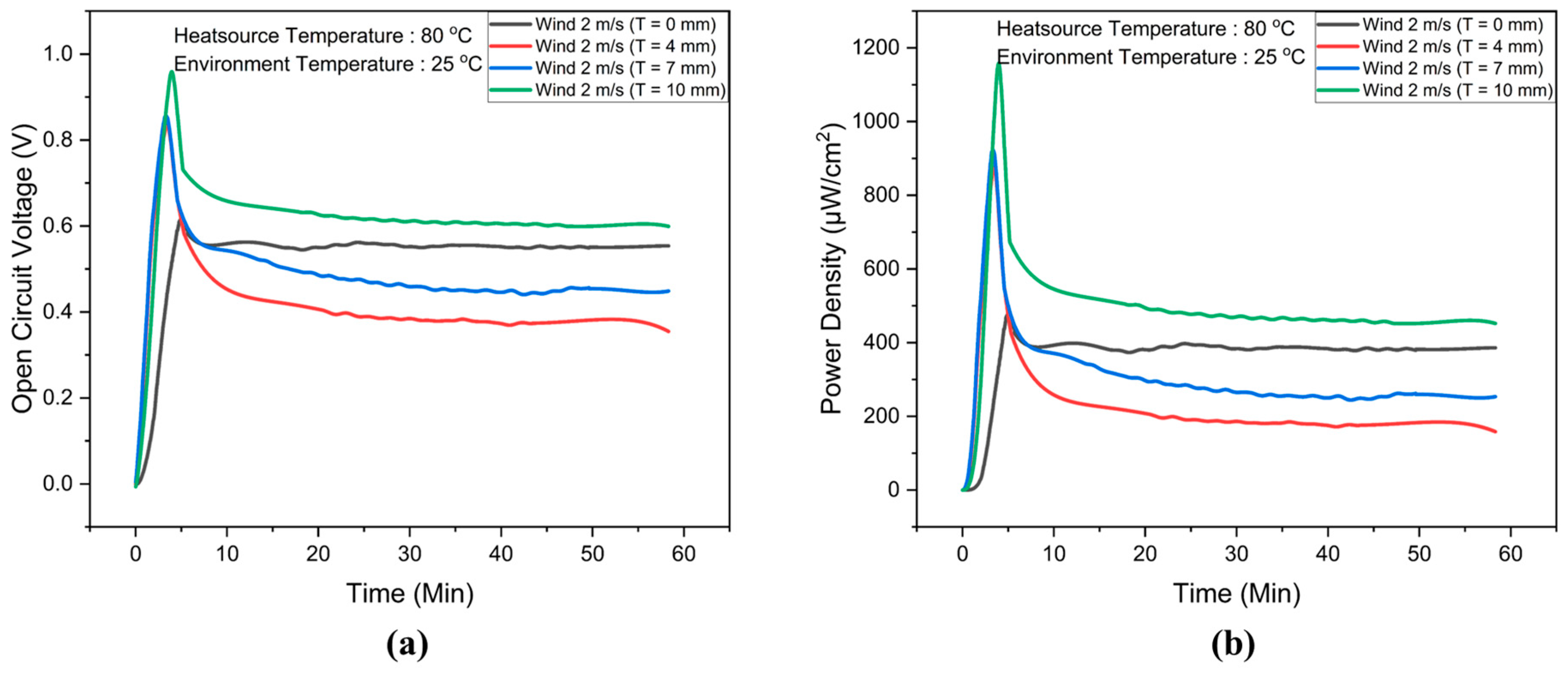
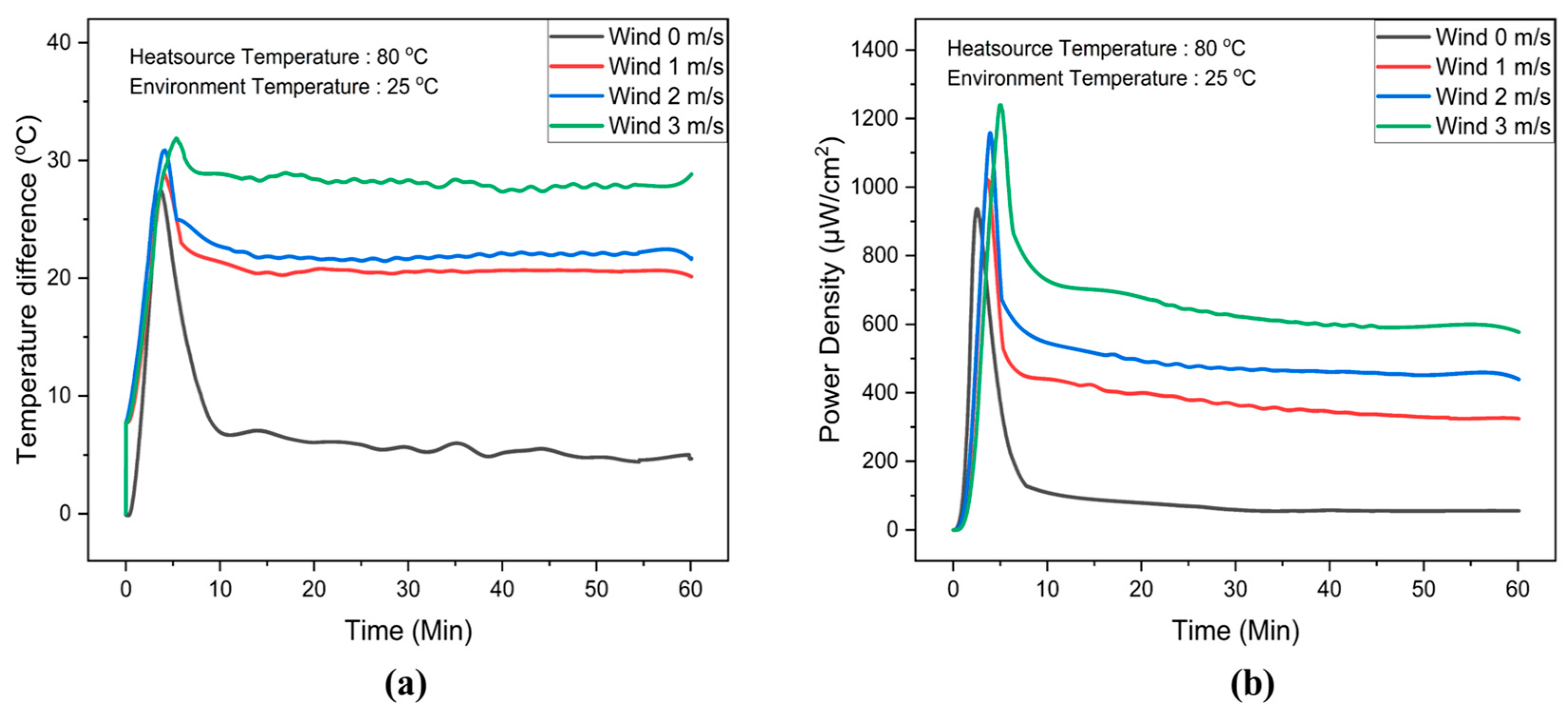
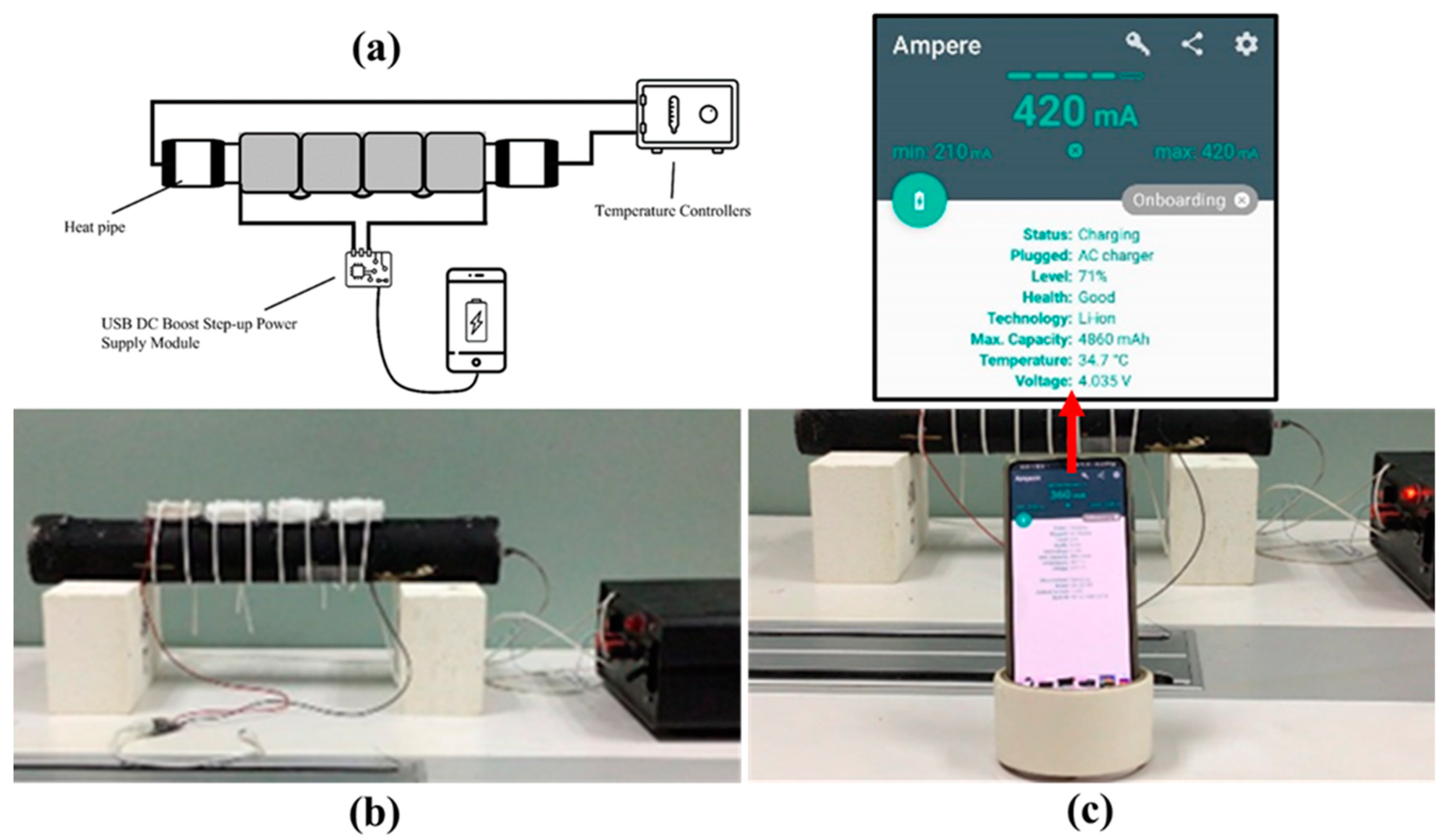
| Properties | Unit | RT42 |
|---|---|---|
| Solidus temperature | °C | 38 |
| Liquidus temperature | °C | 42 |
| Solid density | kg/m3 | 880 |
| Liquid density | kg/m3 | 760 |
| Specific heat | J/(kg·K) | 2000 |
| Latent heat | J/kg | 165,000 |
| Thermal expansion coefficient | 1/K | 0.0001 |
| Thermal conductivity | W/(m·K) | 0.2 |
| Flexible Thermoelectric | Resistance (Ω) | S.D | |||
|---|---|---|---|---|---|
| R1 | R2 | R3 | Raverge | ||
| A | 0.60 | 0.70 | 0.70 | 0.67 | 0.06 |
| B | 0.60 | 0.70 | 0.60 | 0.63 | 0.06 |
| C | 0.70 | 0.70 | 0.80 | 0.73 | 0.06 |
| D | 0.80 | 0.60 | 0.70 | 0.70 | 0.10 |
| Heat Sink | Wind Speed (m/s) | Power Density (µW/cm2) | Reference |
|---|---|---|---|
| Copper electrodes | 2 | 48 | [14] |
| Copper foam | - | 15 | [16] |
| Assembled copper foam onto PDMS film | - | 16 | [17] |
| Assembled copper foam onto PDMS film | 0.8 | 98 | [17] |
| Phase-change material (CaCl2·6H2O) | - | 35 | [25] |
| Phase-change inorganics (CaCl2·6H2O) | 1.5 | 50 | [25] |
| Heteromorphic copper electrode | - | 21 | [18] |
| Heteromorphic copper electrode | 2.1 | 116 | [18] |
| Phase-change material (RT42) | - | 100 | This work |
| Phase-change material (RT42) | 1 | 400 | This work |
| Phase-change material (RT42) | 3 | 625 | This work |
Disclaimer/Publisher’s Note: The statements, opinions and data contained in all publications are solely those of the individual author(s) and contributor(s) and not of MDPI and/or the editor(s). MDPI and/or the editor(s) disclaim responsibility for any injury to people or property resulting from any ideas, methods, instructions or products referred to in the content. |
© 2024 by the authors. Licensee MDPI, Basel, Switzerland. This article is an open access article distributed under the terms and conditions of the Creative Commons Attribution (CC BY) license (https://creativecommons.org/licenses/by/4.0/).
Share and Cite
Egypt, P.; Sakdanuphab, R.; Sakulkalavek, A.; Klongratog, B.; Somdock, N. Optimizing Waste Heat Conversion: Integrating Phase-Change Material Heatsinks and Wind Speed Dynamics to Enhance Flexible Thermoelectric Generator Efficiency. Materials 2024, 17, 420. https://doi.org/10.3390/ma17020420
Egypt P, Sakdanuphab R, Sakulkalavek A, Klongratog B, Somdock N. Optimizing Waste Heat Conversion: Integrating Phase-Change Material Heatsinks and Wind Speed Dynamics to Enhance Flexible Thermoelectric Generator Efficiency. Materials. 2024; 17(2):420. https://doi.org/10.3390/ma17020420
Chicago/Turabian StyleEgypt, Phanathagorn, Rachsak Sakdanuphab, Aparporn Sakulkalavek, Bhanupol Klongratog, and Nuttakrit Somdock. 2024. "Optimizing Waste Heat Conversion: Integrating Phase-Change Material Heatsinks and Wind Speed Dynamics to Enhance Flexible Thermoelectric Generator Efficiency" Materials 17, no. 2: 420. https://doi.org/10.3390/ma17020420





